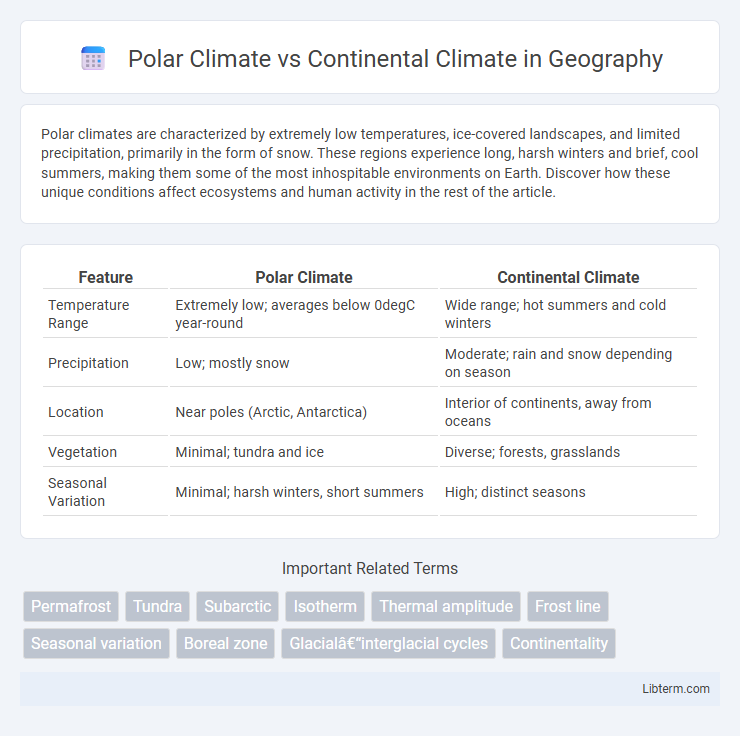Polar climates are characterized by extremely low temperatures, ice-covered landscapes, and limited precipitation, primarily in the form of snow. These regions experience long, harsh winters and brief, cool summers, making them some of the most inhospitable environments on Earth. Discover how these unique conditions affect ecosystems and human activity in the rest of the article.
Table of Comparison
| Feature | Polar Climate | Continental Climate |
|---|---|---|
| Temperature Range | Extremely low; averages below 0degC year-round | Wide range; hot summers and cold winters |
| Precipitation | Low; mostly snow | Moderate; rain and snow depending on season |
| Location | Near poles (Arctic, Antarctica) | Interior of continents, away from oceans |
| Vegetation | Minimal; tundra and ice | Diverse; forests, grasslands |
| Seasonal Variation | Minimal; harsh winters, short summers | High; distinct seasons |
Defining Polar and Continental Climates
Polar climates are characterized by extremely low temperatures year-round, with average monthly temperatures below 10degC (50degF) even during summer months, and are typically found within the Arctic and Antarctic Circles. Continental climates experience more significant temperature variations between seasons, with hot summers and cold winters, often located in the interior of large landmasses away from oceanic influence. These distinctions are driven by geographic location, altitude, and proximity to water bodies, which influence temperature ranges and precipitation patterns.
Key Geographic Locations
Polar climate dominates regions within the Arctic and Antarctic Circles, including Greenland, northern Canada, Siberia, and Antarctica, characterized by long, extremely cold winters and short, cool summers. Continental climate is prevalent in the interiors of large landmasses such as central Russia, northern China, and the central United States, marked by significant temperature variations between hot summers and cold winters. These geographic locations influence the distinct temperature ranges and seasonal patterns defining each climate type.
Temperature Variations
Polar climates experience extreme cold temperatures year-round, with average annual temperatures often below freezing and minimal temperature variation between seasons. Continental climates exhibit significant temperature variations, with hot summers and cold winters due to their location away from large water bodies. This stark contrast in temperature fluctuations is primarily influenced by geographic position and atmospheric circulation patterns.
Seasonal Differences
Polar climates experience extremely cold temperatures year-round with minimal seasonal variation, characterized by long, harsh winters and short, cool summers. Continental climates exhibit pronounced seasonal differences with hot summers and cold winters due to their inland location away from oceanic influence. Seasonal temperature ranges in continental climates can vary by over 40degC, while polar climates rarely exceed a 20degC difference between seasons.
Precipitation Patterns
Polar climates experience minimal precipitation, primarily as snow, with annual totals often below 250 millimeters due to cold air's low moisture capacity. Continental climates display more varied precipitation patterns, with totals ranging between 500 and 1,200 millimeters per year, often peaking in summer months because of convective thunderstorms. These differences in precipitation significantly influence vegetation and water availability in each climate zone.
Flora and Fauna Adaptations
Polar climate flora and fauna exhibit extreme cold tolerance, with vegetation dominated by mosses, lichens, and low shrubs adapted to brief growing seasons and permafrost soils. Fauna such as polar bears, arctic foxes, and seals possess insulating fur, blubber, and behavioral adaptations like hibernation or migration to survive harsh winters and scarcity of food. Continental climates feature diverse deciduous and coniferous forests with animals like deer, bears, and wolves that adapt to seasonal temperature fluctuations through fur shedding, food storage, and hibernation.
Human Habitation and Activities
Polar climates, characterized by extreme cold, limited vegetation, and permafrost, significantly restrict human habitation to small, isolated communities primarily engaged in subsistence hunting, fishing, and research activities. Continental climates, with more pronounced seasonal temperature variations and fertile soils, support larger populations engaged in agriculture, industry, and urban development. Infrastructure and economic activities in continental regions are more diverse and developed due to more favorable environmental conditions compared to the harsh, resource-limited polar environments.
Environmental Challenges
Polar climates experience extreme cold and long periods of darkness, causing permafrost thaw and ice melt that threaten ecosystems and contribute to sea-level rise. Continental climates undergo significant temperature fluctuations and seasonal variations that stress water resources and increase the risk of droughts and heatwaves. Both climates face challenges from climate change, affecting biodiversity, agriculture, and human settlements differently.
Climate Change Impacts
Polar climates experience significant temperature increases due to climate change, leading to accelerated ice melt and rising sea levels that threaten global ecosystems. Continental climates face more extreme temperature swings and altered precipitation patterns, resulting in increased droughts, heatwaves, and disrupted agricultural productivity. Both climate zones exhibit intensified weather events that challenge biodiversity and human adaptation efforts.
Summary Table: Polar vs Continental Climate
Polar climate features extremely low temperatures year-round with minimal precipitation, primarily as snow, while continental climate experiences greater temperature variations between summer and winter and moderate precipitation. Polar regions exhibit permafrost and limited vegetation, contrasting with continental areas that support diverse ecosystems including forests and grasslands. The summary table highlights key differences: temperature range, precipitation levels, vegetation types, and geographic distribution.
Polar Climate Infographic

 libterm.com
libterm.com